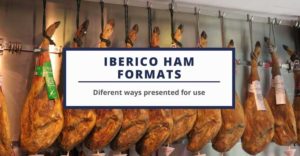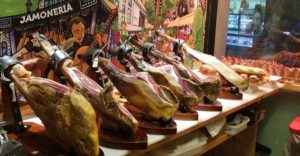Probably, you have been in Spain a lot of times, looking a bar, with a lots Iberico Hams hang out from the ceiling and thought how they are made. In this article, we will describe the process of how and Iberico ham is made from start to finish. If you like this post we will appreciate if you join our newsletter or follow us on social media when you exit the site
Today we will discuss the following:
– Breeding and feeding
– Lifestyle in the Dehesa
– Slaughterhouse
– Salting of Iberico Ham: buried in salt
– Settlement of Iberico Ham
– Drying of Iberico Ham
– Maturity of Iberico Ham
To make this precious delicacy, producers use the back legs for the hams, and the front for shoulders called Paletillas. The rest is used to elaborate cured meats, like Iberico chorizo, Iberico salami, Iberico morcon, Iberico Pork loin, or to sell as raw meats like (presa, secreto, pig cheeks, loins, steaks…). So, how is made? How this delicious product is transformed?
Breeding and feeding
Birth and suckling piglet: the gestation of the mothers lasts three months, three weeks and three days. After the piglets will have between 700g to 1 kg, usually 8 piglets will be born more and less. They can recognize the voice of their mothers at 24 hours of birth.
The piglets will be called piglets until they finish breastfeeding, with already around 20kg of weight.
Rearing stage: after breastfeeding finishes, they will learn to eat cereals, dried nuts and cereals feed, growing strong and developing a solid muscular structure and bones. This phase lasts until they weight 30 kg.
The last phase before Montanera called “primales”: With more than 50kg in total and previous to Montanera. The pigs have around 7 months old and will be in the phase other 10 months more. Then are ready to move to Dehesa
Lifestyle in the Dehesa
After the breeding and the feeding, the pigs will spend all the time in the Dehesa eaten around 8kg of acorns a day plus 3kg of grass and aromatic herbs. In particular, acorns from holm oaks and cork oaks, rich in carbohydrates and sugars than make the fattening of the pigs faster during the montañera season.
The Iberian pigs have plenty of space to move, water to cool off and have a bath. Thanks to the diet they have and the quality of the breed, the pigs are stylized in comparison with other breeds. Which makes the hams elongated, thin and with an excellent fat infiltration.
Because Iberian pigs are eaten acorns and herbs constantly, the fats infiltrate in the muscular system on the animals, having this tasty and special intramuscular fat you see when cutting, or eating an Iberico Ham. Ones the animals reach 160 kg, is time to go to the slaughterhouse.
Slaughterhouse
This step of the process, is really important to obtain high-quality hams. In general, the legs are trimmed in a rounded cut approximately 5cm under the leg bone. When this cut is done, extras of fat, cartilage and other waste will be removed.
It is crucial at this stage, to apply a massage from the inside to the outside, or from the centre of the ham to the hoof, to make sure than no blog will remain throughout the leg.
Salting of Iberico Ham: buried in salt
Leaving 1 day per kg of meat in the salt, with oscillating temperatures from 0º to 5º C and a 70% to 90% humidity. This process can vary from each producer, as each of them has their own secrets. If they exceed the time, the ham can be ruined and really salty to commercialize.
During the salting process, is important to turn round the legs of Iberico ham. Ones the salting finishes the salt will be removed, manually washed with water and special brushes. If any excess of blood remains, will be removed with a massage from the centre to the hoof.
Settlement of Iberico Ham
A period of 35 to 45 days of the settlement (saline balancing process) will be required. Controlled temperatures between 0º to 6º C and 80% to 90% of humidity will be applied.
Drying of Iberico Ham
2 Steps on the drying process where the 1st one will estimate around 3 months with a temperature between 6º to 16º C and humidity around 70%.
The 2nd part of the drying will be slightly shorter with the rise of temperature from 16º to 30º C, and the humidity can vary.
Maturity of Iberico Ham
Some producers, grease the hams before with Manteca or olive oil to cure them. Is one of the critical points than make an Iberico ham excellent, where the meat will lose part of the fat while the other part will distribute through the muscular fibres to obtain this exquisite aroma and excellent taste than make the Iberico hams a top world food product.
In maturity, the temperature will oscillate between 15º to 20ºC with a relative humidity of 60% to 80%. During this process, the Iberico ham will experiment enzymatic and biochemical changes. Through time will give especial qualities, aromas, flavours and impressive texture.
The producers open and close the windows, making the climatic conditions influence the process of drying and give these special characters to the ham.
When the Iberico ham is mature a “cala” will be applied, this “cala” consist of introducing an awl usually made with cow bone. The ham expert with its excellent olfactive qualities will determinate the quality and if the ham is ready to sell
The legs are exposed to no natural currents of air on the critical moments, cooling the pieces in a natural way. Closing the windows will maintain adequate humidity and temperature.
On the dryer facilities, the legs are hanging out with sufficient separation between them. The objective is a homogeneous condition of humidity and temperature thanks for the right circulation of air.
The location of the facilities are not chosen at random, need to be in the region of medium to low temperatures and low relative humidity
The specialist said, a slower and longer process of aging and curation, the better the Iberico ham will be. The curation on the bodega can last between 2 to 4 years, depend on the criteria of each producer.



